Flag of Kurdistan
The Flag of Kurdistan (Kurdish: ئاڵای کوردستان ,Alaya Kurdistanê) was created by Xoybûn during the Ararat rebellion against Turkey in 1928, where it was hoisted by thousands of Kurdish rebels.[1] The flag was subsequently presented to the European powers at the Versailles Peace Conference.[2] When the Republic of Kurdistan in Iran was proclaimed in 1947, Mustafa Barzani hoisted the flag in Mahabad and the flag was adopted as the official flag of Kurdistan. Iraq's Kurdistan Region has since adopted the same flag as the official flag.[3][4][5][6]
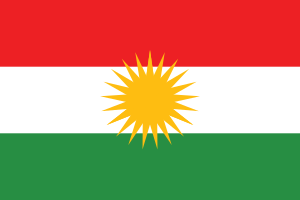 | |
| Name | Alaya Rengîn ("The Colourful Flag") |
|---|---|
| Proportion | 2:3 |
| Adopted | 1920s by Xoybûn 1992 by Kurdistan Region |
| Design | A red, white, and green tricolour, with a yellow 21 rayed sun in the center. |
Symbolism
The Kurdish flag is the most important symbol of cohesive Kurdish identity. Since it was first hoisted in 1946 to represent the concept of an independent Kurdistan (called the Republic of Mahabad and founded in Iranian territory) it has become a symbol of the national identity of Kurds.[7]
The main characteristic of the flag is the blazing golden sun emblem (Roj in Kurdish) at its center. The emblem's sun disk has 21 rays, equal in size and shape, with the single odd ray at top and the two even rays on the bottom. Number 21 is a venerated number, standing for rebirth/renaissance in the ancient and native Kurdish religion of Yazdanism and its modern offshoots.[8] The golden sun emblem has been in use by Kurds since antiquity.[8]
The symbolism of the colours is:[6][9]
| Colour | Meaning |
|---|---|
| Red
RGB: (235,35,35) HEX: #ED2024 |
Symbolizes the blood of the martyrs and the continued struggle for freedom and dignity. |
| Green
RGB: (39,138,65) HEX: #278E43 |
Expresses the beauty and landscapes of Kurdistan. Life and vitality. |
| Yellow
RGB: (250,185,20) HEX: #FEBD11 |
Represents the source of life and light of the people. The sun is an ancient symbol and twenty one sunbeams represent March 21, Newroz. |
| White
RGB: (255,255,255) HEX: #FFFFFF |
Represent peace and equality. |
In Fall 2006 the Iraqi Kurdish leadership gave orders for Kurdish officials to stop flying the Iraqi flag under decree number 60 "to hoist the flag of Iraqi Kurdistan". Masoud Barzani issued orders that the Ba'athist flag should be lowered and all regions in Iraqi Kurdistan should "hoist only the Kurdistan flag" because the symbols of Ba'athism were associated with the Anfal genocide where 180,000 people lost their lives. When the Ba'athist symbols were removed from the Iraqi flag in 2008, the KRG hoisted the Iraqi flag to fly alongside the Kurdish flag, reported to still be the practice as of March 2013. Flying the Iraqi flag side by side with the Kurdish flag is symbolic of their acceptance of Iraqi federalism.[10]
History
The flag first appeared during the movement for Kurdish independence from the Ottoman Empire and resembles an earlier version created by the Xoybûn (Khoyboon) organization, active in the Ararat rebellion of 1930,[11] and flown by the break-away Republic of Ararat during the period 1927–1931. The flag appeared then again in 1932 and in the media where one of its creators described it as red, white and green with a sun in the middle.[12]
Chronology
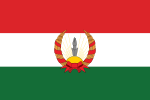 Flag adopted by the Republic of Mahabad in the mid 1940s.[13]
Flag adopted by the Republic of Mahabad in the mid 1940s.[13] Third and current version of the flag, adopted by the Kurdistan Region in 1992;[13] used also by nationalist Kurdish parties in Iran,[14] Turkey,[15] and Syria.[16]
Third and current version of the flag, adopted by the Kurdistan Region in 1992;[13] used also by nationalist Kurdish parties in Iran,[14] Turkey,[15] and Syria.[16]
Modern adaptation to international flag standards
The flag appeared in Kurdish media throughout the 1990s with MED TV, Kurdsat, Kurdistan TV and their affiliates broadcasting with the flag appearing frequently in their programming allowing it to become a symbol of Kurdish statehood.[17][18] A document dealing with the adaptation to international flag standards of the National Flag of Kurdistan was prepared by Mehrdad Izady and Bijhan Eliasi in 1998.[8] It was instantly adopted by the international Flag Institute. In 1999, the Parliament of the Kurdistan Regional Government adopted the standardized flag to be the official and standard presentation of the Kurdish National Flag in all its aspects.
Other flags used by Kurds


.svg.png)
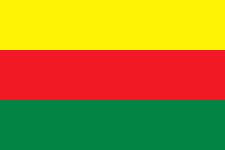 The Tricolor flag of TEV-DEM, adopted circa 2012, commonly used by Kurds in the Autonomous Administration of North and East Syria.
The Tricolor flag of TEV-DEM, adopted circa 2012, commonly used by Kurds in the Autonomous Administration of North and East Syria.
Similar flags
Due to Iranian roots of the Kurds,[22] the colours used in flags used by Kurds are the same that are used in other Iranian-origin areas like Iran and Tajikistan.[23]
.svg.png)


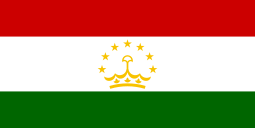

 Flag of Hungary since 1990.
Flag of Hungary since 1990.
Kurdistan Region's flag day
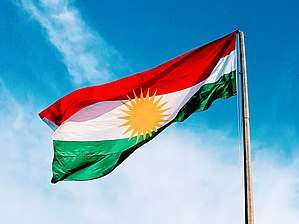
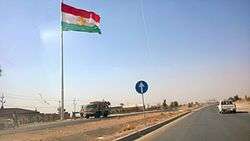
Established by the Kurdistan parliament in 1993, Kurdish Flag Day is celebrated on December 17. Activities done on this day consist of dancing, eating, and celebrating.[24][25][26]
References
- Harriet Allsopp (2016). The Kurds of Syria: Political Parties and Identity in the Middle East. ISBN 0857726447.
- "The National Flag of Kurdistan". Institut Kurde de Paris. Retrieved 2 June 2019.
- Parameśa Caudhurī (2005). India in Kurdistan. University of Michigan. pp. 245–246.
- The Last Mufti of Iranian Kurdistan Ethnic and Religious Implications in the Greater Middle East. Palgrave Macmillan. 2016. p. 27. ISBN 1137563249.
- Aziz, Mahir (2014). The Kurds of Iraq: Nationalism and Identity in Iraqi Kurdistan. I.B.Tauris. p. 130. ISBN 9781784532734. Retrieved 16 November 2016.
- Danilovich, Alex (2016). Iraqi Federalism and the Kurds: Learning to Live Together. Routledge. p. 101. ISBN 9781317112938. Retrieved 16 November 2016.
- Iraqi Federalism and the Kurds: Learning to Live Together
- Dr. M. R. Izady. "The National Flag of Kurdistan". Encyclopaedia Kurdistanica. Archived from the original on 1 May 2008. Retrieved 6 June 2008.
- HUMANRIGHTSWATCH (1992). "Turkish Forces Kill Scores of Peaceful Demonstrato Turkish Forces Kill Scores of Peaceful Demonstrators" (PDF). Helsinki Watch. 4 (9): 8. Retrieved 16 November 2016.
- Iraqi Federalism and the Kurds: Learning to Live Together
- "The National Flag of Kurdistan"., Kurdish Institute of Paris.
- "Ala û sirûda netewiya Kurdistanê". Kurdistan Regional Government. Retrieved 16 November 2016.
- "Years before independence talk someone had foresight to standardize the Kurdish flag". Rûdaw. 21 June 2017. Retrieved 6 June 2019.
- "PAK leader: Kurds only have one problem". Kurdistan24. 12 January 2016. Retrieved 6 June 2019.
- "Rafet Şahin ölümünün 1. Yılında HAK-PAR İstanbul İl Binasında anıldı" (in Turkish). Hak-Par. 28 April 2019. Retrieved 6 June 2019.
- "ENKS confirms representation of Kurds in Geneva". Kurdistan24. 31 January 2019. Retrieved 6 June 2019.
- Haiderali, Karim (2003). The Media of Diaspora. Psychology Press. pp. 82–83. ISBN 9780415279307. Retrieved 16 November 2016.
- Kontra, Miklós (1999). Language, a Right and a Resource: Approaching Linguistic Human Rights. Central European University Press. p. 228. ISBN 9789639116641. Retrieved 16 November 2016.
- Kurdistan: Short-lived independent states, Flags of the World (1997). The Flags of the World website shows the Soran and Ararat flags as contributed by Jaume Ollé in 1997 without any reference. Only the flag of the Kingdom of Southern Kurdistan is explicitly based on sources, "The flag is shown in two sources: (a) a 1922 photograph of the Kurdish Army taking an oath of allegiance. (b) a sketch with notes on the colours by Ahmed Khwaja in his autobiography Cim Di (1970)." (T. F. Mills, 25 November 1997).
- "Kurds declare federal region in Syria's north". France 24. 17 March 2016. Retrieved 12 June 2019.
- "Why Syria's Kurds want federalism, and who opposes it". Al Jazeera. 17 March 2016. Retrieved 12 June 2019.
- Foltz, Richard (2016). Co-Opting the Prophet: The Politics of Kurdish and Tajik Claims to Zarathustra and Zoroastrianism In book: The Zoroastrian Flame: Exploring Religion, History and Tradition. I.B.Tauris. p. 325-341. ISBN 9781784532734. Retrieved 16 March 2018.
- Tajikistan flag. "Tajikistan flag". Graphic Maps.
- Learn About the Kurdistan Flag. "The Kurdish Project". The Kurdish Project.
- On Kurdistan's National Flag Day. "Kurds show solidarity with Peshmerga". ekurd.net.
- December 17, Flag Day. "Kurdistan Region: Flag Day". www.pukmedia.com.
| Wikimedia Commons has media related to Kurdish flags. |